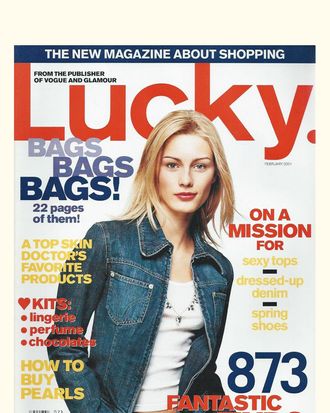
At some point in 1998, my most serious professor, the one for whom I’d read Pynchon and Nabokov, invited me to a party at his house where he was hosting an alumna who’d made it as a magazine writer. I remember little of that evening, save my struggle to dress to impress. Kim France held the floor, impossibly cool, sophisticated, and grown-up — though she was then several years younger than I am now. As I was leaving she told me she’d see me in New York someday, “Probably at Barneys.” I had no idea what that meant.
When, a year later, I tracked down an email address and sent the sort of beseeching missive college graduates often send, France replied, kindly, inviting me to the office where she was toiling on a top-secret project. A few weeks after our very brief meeting I received an email, the entirety of her message embedded within the subject line: Did I want to come work at Condé Nast and be her assistant?
The $25,000 salary seemed princely (I was employed, at the time, at a coffee shop), but that was beside the point. I was so happy just to have been invited into the legendary Condé Nast. The pristine new building was lousy with equine blondes; it was as though I, a brown boy from an unremarkable suburb, had somehow evaded quality control. I spent my days ordering flowers for the office, coordinating with the car service, and checking in with the assistants of other powerful people in the company, organizing lunches for our bosses like parents scheduling play dates. But I was determined to make it a learning experience. I asked idiotic questions — like what the woman whose title was “publisher” was responsible for — and I watched and listened.
Lucky trumpeted on its cover that it was “the magazine about shopping.” Of course, we’ve come to understand that every magazine is about shopping, but Lucky was the first to admit it. In today’s world of click-to-buy, it seems obvious that when magazines tell you to buy something, they should show you how much it costs and direct you to where it can be found. Yet, Lucky was the first Condé title to do that. Many established editors thought Lucky ridiculous, but the readership was devoted, which I know firsthand, as I was responsible for reading the general email inquiries: fan letters, personal notes from old Sassy readers, insanely specific requests. Lucky, in its early iteration anyway, celebrated fashion in a very pure way: A piece from some obscure catalogue could be deemed as worthy as one by Marc Jacobs, and inexpensiveness was cause for celebration, not shame. Lucky made shopping into a sport.
After a time, I worked mostly as a writer for the magazine. Other people who worked in publishing would sneer/recoil/chuckle — was there even writing in Lucky? That I worked as a writer at Lucky never impressed a single person in the business, which is a shame because Lucky’s voice and style (brevity, an insistent avoidance of repetition) taught me a hell of a lot about writing, possibly more than my undergraduate writing workshops. If you think I am overstating it, try writing 24 captions about essentially identical black shoes, or beaded handbags, or two-piece bathing suits; you can’t repeat a word among those, and the construction of each must be different, otherwise the editor-in-chief is going to throw a red pen at you. It’s like playing word Jenga, or composing tidy, little fashion haikus.
As I drifted into the advertising business — getting out of Condé Nast just before the recession of 2008 that claimed the lives of Domino, Cookie, Gourmet, and Portfolio — every client I met loved that I had come from Lucky. They knew that meant I knew something about words. Truly smart people and truly smart dressers share one thing in common: They make it look easy. That weird, old magazine that, like me, somehow snuck past Condé Nast’s quality control was the brainchild of people both smart and fashionable, and it made it look easy. I’ll miss it.




